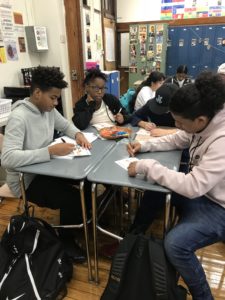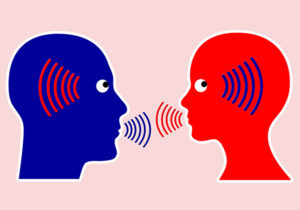
Interpersonal communication involves two-way, spontaneous interaction
I have taught high school Spanish for almost thirteen years, and the phrase I most frequently proclaim is “¡En español!” If I had a dollar for every time I uttered these words, my early retirement would most certainly be secured. In fact, here is an example from just last week of me encouraging my students to stay in the target language in a novice-level Spanish class. Listen carefully what happens after I say ¡en español!
One major goal for World Language classes at Essex Street Academy is that students become confident speakers of either Spanish or French. My Spanish classes are filled with lots of opportunities for questions and answers, an abundance of comprehensible input through text, visuals, and audio, and daily guided practice. I make it clear that fluency is valued over accuracy; that is, I much prefer that students take risks and make mistakes rather than staying quiet, debilitated by linguistic perfectionism. Getting one’s point across and being comprehended by a native speaker is what truly matters when speaking a foreign language.
My job as a language teacher then is to create a classroom where students’ filters are low and where they can feel safe, comfortable, and supported when speaking Spanish. Based on the little you’ve read about my beliefs around second language acquisition, you might assume that my classroom is a perfect incubator for learning Spanish….if that’s what you think, then take a look at the picture below. Ideal classroom, isn’t it? The answer would be yes if students were not speaking in English while completing the activity seen in picture. However, students used English as a vehicle of communication to complete a task where answers needed to be in Spanish. Although my hopes were for Spanish to be spoken, the task I created did not make speaking Spanish a necessity for task completion.

More than anything, I want students to engage in interpersonal speaking with each other. Interpersonal speaking is perhaps the most authentic way of communication among human beings. In World Language education, Interpersonal Communication involves conversation between two or more people that is spontaneous and unrehearsed. In terms of the Framework for Authentic Instruction, getting students to speak to one another in Spanish is most closely aligned with Authenticity to the Discipline. If our goal as language teachers is for students to communicate in the target language as native speakers do, a classroom where students are engaged in tasks that compels them to use Spanish to negotiate meaning with their peers seems as authentic as it gets! In short, my problem of practice can be stated as such: How might we create routines and tasks in the Spanish classroom so that students engage in authentic conversations with each other?
I am excited about this topic because I want to instill a sense of purpose in classroom tasks. I want students to be careful listeners as they converse with their peers, but I also want them to be able to formulate information, articulate opinions, and give suggestions, all in Spanish. Ideally, I want students to build empathy for one another as they hone their interpersonal speaking skills.
Moving forward, I do anticipate some real obstacles in creating authentic tasks in the Spanish classroom. The biggest challenge that I envision is the one I have always faced: students feel uncomfortable speaking to each other in Spanish when they can readily communicate in English. I will need to create a classroom environment in which students feel comfortable with being uncomfortable. Furthermore, I will need to create a monitoring system to ensure that students speak to one another in Spanish and that they receive appropriate corrective feedback. Fostering a classroom culture of risk-taking, encouraging individual and collective responsibility, and supporting comprehensible language production are just a few of the outcomes I hope will result as I tackle my problem of practice.


Perhaps you can pose this question to your class and get feedback. That would reflect and implement personal authenticity. Sometimes our students have answers that are beneficial.
So true, Adrienne! You just inspired me to incorporate that question into my lesson for tomorrow! ¡Muchas gracias!
I have a few thoughts. First of all, bravo!
I am in awe of your bravery and gusto in the face of significant resistance inside your classroom. I remember how scared I was to speak in a new language. It is hard to convince adolescents to be uncomfortable. I also remember that the first time I had to speak with someone who spoke no English took that comfort zone away for me and I had to keep spinning until I could communicate. Could you possibly introduce the students once a week to a person who speaks little to no English. In order to introduce themselves, they would have to speak the target language and ask one or two questions in the target language? Or what about video chatting with a Spanish classroom that is taking English 1. Could they try and communicate with each other?
What about upping rewards for no English heard at all. If the room is English free for twenty minutes there will be group prizes (munchkins, extra credit, a spanish music video)
It strikes me that it is like Mavis Beacon. I cheated and looked when I was supposed to learn how to type correctly and I still don’t know how to type with the proper fingers. Perhaps if I couldn’t have peaked at all then I would have learned. Can we keep them from peaking? It strikes me that it is definitely worth the shot (after lots of practice, scaffolding, and modeling of course!)!
How about having kids take turns being “Spanish-only” monitors in the classroom?
Yes, Cristie! I will most certainly make that a classroom job 🙂
These are such great ideas, Jackson! The Munchkin incentives is a great idea–I’ll be sure to put that one out there. I would very much like for students to authentically engage with monolingual Spanish speakers. I need to be more proactive about inviting them in and having them speak to students. These are phenomenal ideas.
Hi Chris,
I really appreciate your post. It is so important for us as student teachers to also see our own teachers incorporate some of the same strategies that we’re always talking about like fostering more genuine interpersonal communication among students. I loved the idea of posing your question to your students. I am curious to hear what they have to say about building more authentic dialogue in their classroom. Please share your feedback with our seminar class!